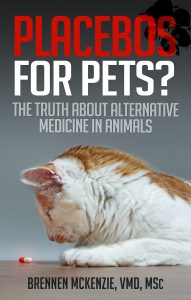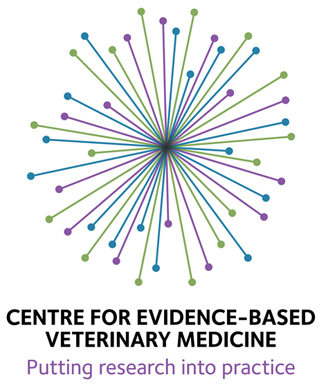What Are Vaccines?
The principle behind vaccination is that small amounts of weakened or killed organisms that normally cause disease, or even just pieces of these organisms, are given to an animal. This stimulates the immune system to generate a protective immune response without an actual infection or illness.
The first experiments with vaccination in dogs were conducted by Louis Pasteur in 1884, but reliably safe and effective vaccinations for most disease were not routinely available until the 1950s or later. Since vaccination became commonplace, the incidence of rabies, distemper, parvovirus, and many other infectious diseases has decreased dramatically. Along with improvements in nutrition and the development of antibiotics, vaccines have been among the most successful medical interventions for reducing disease, suffering, and death in companion animals.
But like all effective medical treatments, vaccines are not without risks, and recently there has been an increase in concern about their safety. Fortunately, there has also been a great deal of research into the benefits and risks of vaccination, and this information can help veterinarians and pet owners to make appropriate decisions about the best way to safeguard their pets’ health.
Why Vaccinate?
There are many infectious diseases that affect dogs and cats. Some cause severe, life-threatening illness. Some cause mild symptoms that can resolve spontaneously or persist for years. And some, such as rabies, can cause disease in humans as well as our pets.
The most obvious benefit of vaccination is preventing illness in the individual given the vaccine. This is especially clear with vaccines that are highly effective at preventing potentially fatal infections, such as canine distemper, canine parvovirus, and feline panleukopenia. Even those vaccines that do not prevent illness can reduce the severity of symptoms, as in the cases of several upper respiratory viruses in cats.
A less well-know but very important benefit of vaccination is to prevent epidemics in a population of animals, through what is called herd immunity. If a large number of individuals are protected by vaccination, there are not enough susceptible animals to allow a disease to spread, and so even unvaccinated individuals are protected from infection. When vaccination rates drop, however, then a few isolated cases can turn into a widespread epidemic.
There have recently been outbreaks of measles and haemophilus influenza B among humans as a result of fewer people in some areas getting vaccinated for these diseases. And in 1994-1995 there was an epidemic of canine distemper in Finland, where the disease had previously been eliminated, largely because too few dogs were adequately vaccinated.
The proportion of the population that must be vaccinated for herd immunity to work depends on the prevalence of the disease, the effectiveness of the vaccine, and other factors, but in most cases more than 90% of individuals must be vaccinated for those who are not to be protected. So if even a few individuals do no receive adequate vaccination, an epidemic can potentially develop.
Finally, vaccination of pets can be important for the health of their owners and other humans. Human cases of rabies due to dog bites, which is nearly always fatal, were once a serious public health problem in the United States. Widespread vaccination of dogs has eliminated this threat, though it is still a serious risk for people, especially children, in countries where such vaccination is not available or utilized.
Do They Work?
For many serious diseases, vaccination is very effective. There is some variation between vaccines, but the efficacy for vaccination against canine distemper, canine parvovirus, rabies, feline panleukopenia, and feline leukemia is excellent, in some cases close to 100%. Other vaccines, such as those for feline herpes virus and feline calicivirus, may not prevent infection but may markedly reduce the symptoms the infected pet suffers. However, there are some vaccines that are considered only poorly effective and others for which not enough information exists to determine how well they work.
As already mentioned, herd immunity depends to some extent on how common the disease organism is in the environment, how effective the vaccine is, and what percentage of the population is vaccinated. Even for vaccines with weak efficacy, if most animals are vaccinated then epidemics are less likely. And even when a vaccine is very effective, if many unvaccinated individuals are present to spread the disease, epidemics can develop.
What, When, How Often?
When many of the common vaccines were introduced decades ago, there was limited information on how effectively they protected animals from disease and for how long. The common practice was to give vaccines for many different diseases routinely every year. Significant improvements in our understanding of how vaccination works to prevent disease has led to widespread abandonment of this practice. The precise vaccines to be given, when, and how often can only be determined on an individual basis, considering the exposure of the patient to specific diseases, the effectiveness and risks of available vaccines, and many other factors. Some general principles, however, are applicable to all individuals.
Puppies and kittens that nurse usually receive antibodies from their mothers. These antibodies offer some protection from infectious diseases, though how much protection and for which diseases depends on many variables and is very difficult to predict. These maternal antibodies, however, also interfere with the action of vaccines. As puppies and kittens mature, they gradually lose their maternal antibodies and, if vaccinated, develop their own. For most individuals and most diseases, maternal antibodies begin to decrease by 6-8 weeks of age and are effectively gone by 14-16 weeks of age. As the level of maternal antibodies decreases, the young animals are at more and more risk for contracting infections until they have produced sufficient protective antibodies of their own.
For this reason, young animals must receive a series of vaccinations between 6 and 16 weeks of age. Because it cannot be determined exactly how much protection each individual has from nursing or how long that protection lasts, a series approach to vaccination maximizes the development of the patient’s own antibodies and minimizes the risk of gaps in protection as the maternal antibody levels decline.
For adult animals, the vaccines that will best protect them depend on individual circumstances. Current recommendations divide vaccines into core and non-core categories. Core vaccines are those that protect against organisms which cause severe disease, are easily transmitted between animals, are widespread in the environment, and for which the vaccines are recognized as safe and highly effective. Non-core vaccines are those used for organisms that cause mild self-limiting disease, are not widespread or easily transmitted, or for which the vaccines are not highly effective or carry unacceptable risks. Non-core vaccines are still appropriate to use if warranted by circumstances, but unlike core vaccines are not generally recommended for all pets
Finally, a few vaccines are generally not recommended at all due to uncertainty about their safety or efficacy or other concerns.
It is generally recommended all animals receive core vaccines at regular intervals and only receive non-core vaccines if the individual’s circumstances suggest the benefit outweighs the risks. For dogs, most veterinarians consider core vaccines to be those against canine distemper, parvovirus, hepatitis, and rabies. For cats, feline panleukopenia, herpes virus, and calicivirus vaccines are generally consider core vaccines. There is some debate about whether rabies and feline leukemia vaccines should be considered core vaccines for cats, and this depends mostly on a given cat’s likelihood of exposure, age, and the local rabies vaccination laws.
How often to give vaccines to adult animals is a topic of vigorous debate. Differences in individual immune function, in vaccine efficacy and safety, in regional risk of exposure to specific diseases, in individual or breed predisposition to diseases and response to vaccines, and many other factors make it nearly impossible to make definitive and universal statements about how long a vaccine will protect a given patient. A broad consensus exists among veterinarians and researchers that the initial puppy or kitten series of core vaccinations and a booster one year later is appropriate for almost all animals. There is strong evidence that most core vaccines will provide adequate protection for most individuals if given at most every 3 years, and for some diseases protection likely lasts much longer. However, there is insufficient evidence for detailed and universal guidelines for most vaccines.
There is little research on vaccines in geriatric animals. Older pets do respond to vaccines with an appropriate increase in immunity, and they do not seem to be at an increased risk of dverse reactions from vaccines. There is no sound evidence to suggest that vaccination should be stopped at any particular age.
A general principle of medicine is that the benefit of a treatment should exceed the risk, so much of the discussion about how often to vaccinate and for which diseases centers on what is know about the risks of vaccination.
Are They Safe?
Like any potent medical therapy, vaccines can have unintended effects. Since vaccines are commonly given, often multiple times over many years, it can be difficult to decide if an illness is related to previous vaccination. In humans, there has been much concern about vaccination being responsible for autism in children, since the disease tends to emerge at about the time most children are vaccinated. Only after years of extensive research in thousands of children throughout the developed world has this theory been convincingly disproven. High quality research on this large a scale is rarely possible in veterinary medicine.
However, some good quality studies have been done to determine what adverse effects vaccines might cause, and how common and serious these are. Estimates vary, largely because it is often impossible to determine what the total population of dogs or cats is, what percentage of these have been vaccinated when and for what, and to gather other information necessary to accurately determine how common vaccine reactions really are. On the high end, estimates of total adverse vaccine reactions, provided by manufacturers based on pre-clinical testing, are on the order of 100 reactions per 10,000 vaccine doses given. Numbers based on research in actual pet populations are much lower, ranging from less than 1 reaction per 10,000 vaccines given up to 13 reactions per 10,000 doses given in dogs and 20 per 10,000 doses given in cats.
The most common by far are local or systemic hypersensitivity reactions, usually called allergic reactions. These account for 30-60% of adverse vaccine reactions. The vast majority of these reactions that are seen by a veterinarian resolve spontaneously or with minimal medical treatments. Many localized allergic reactions are thought to resolve without ever being noticed by the owner or reported to a veterinarian.
The risk of allergic reactions is not the same for all pets. Smaller dogs are at greater risk than larger dogs, and the risk increases the more vaccines are given at one time. Some research suggests certain breeds may be at higher risk than others, but other studies do not support this.
More serious adverse reactions are much rarer. A disease in which the immune system attacks the patient’s own red blood cells (IMHA) has been reported in one study to be associated with vaccination at a rate of 0.01 reactions per 10,000 doses, though a more recent study of the same disease found no association with vaccination. Other autoimmune diseases have been reported in specific breeds (such as hypertrophic osteodystrophy after canine distemper vaccine in Weimeraners and localized vasculitis in Dachshunds), but these are uncommon to rare and linked with specific genetic predispositions in affected dogs. It is also important to remember that these diseases can also be triggered by the very infections vaccines are used to prevent as well as medications, natural substances in food and in the environment, and anything that stimulates a response in the immune system of a predisposed animal.
The most widely known adverse vaccine reaction in animals is a rare type of cancer in cats known as Vaccine Associated Sarcoma (VAS). Identified by careful research in the early 1990s, this tumor has been linked to specific vaccines for rabies and feline leukemia. Similar tumors can occur spontaneously or in response to trauma, foreign bodies, local infections, and other things that stimulate the immune system. However, the risk of VAS is significantly increased by these vaccines, and it is suspected that the reason is certain ingredients, such as aluminum, that were added to the vaccines to increase their stimulation of an immune response. Estimates vary, but the most reliable figures suggest VAS occurs at a rate of 0.3-2 tumors per 10,000 vaccine doses given.
The discovery of this tumor stimulated much concern about the safety of vaccinations. While it is quite rare, great efforts have been made to reduce the incidence of VAS by developing new vaccines and researching the safest way to use these vaccines to protect cats from infectious disease while minimize such reactions. The debate and research has even spread beyond feline leukemia and rabies and stimulated a significant change in vaccination practices generally for both dogs and cats.
Finally, it is vital not to forget that the risks of vaccination must be considered in light of the benefits. For most core vaccines, the diseases they protect against represent a far greater threat to the health of our pets than the vaccines.
Vaccine Myths
While careful evaluation of the risks and benefits of vaccination, and cautious and thoughtful use of this potent medical tool, is absolutely appropriate, irrational fear of vaccines has unfortunately led to the spread of many myths about them. Some of the concerns raised about vaccines used in humans have been extended to companion animal vaccination, despite the evidence that many of these concerns are unfounded. And it has become all too common to identify vaccination as a possible, or even probable cause for any disease that is not yet completely understood. While unknown and unpredictable risks are always possible, careful scientific research has discovered even such rare adverse effects as Vaccine Associated Sarcomas, and many of the purported negative effects of vaccines are merely wild speculations with no basis in fact.
The most common myth about vaccines is that they are not necessary since the diseases they protect against are rare. The diseases for which we have core vaccines in dogs and cats all continue to exist in the population as a threat to unvaccinated individuals. And in cases where vaccine rates have dropped due to this misconception, epidemics of some of these diseases have occurred.
Another common concern are the immune system diseases caused by vaccines. Though auto-immune diseases such as IMHA may be associated with vaccination, this has not been conclusively demonstrated. And if vaccines do precipitate such diseases, so do infectious organisms, natural substances in food, and many other possible environmental factors. These conditions are uncommon, and any risk of them posed by vaccination is undoubtedly outweighed by the protection the vaccines offer against serious infectious diseases.
Some vaccinated animals have been shown to have antibodies against normal proteins in their own bodies, including the thyroid gland and the kidneys, and this has stimulated speculation that diseases in these organs may be the result of vaccination. However, the relationship between vaccination and such antibody formation is inconsistent, and no actual immune-mediated disease has ever been shown to result from the presence of vaccine-induced auto-antibodies.
Much publicity has been generated by concerns over “toxins” in vaccines. Thimerosal, aluminum, formaldehyde, anti-freeze, and many other substances have been claimed to be present in vaccines and to be harmful to vaccinated people or animals. Some of these substances are present in minute quantities in vaccines, though others are not. The primary misconception that creates unjustified fear about these ingredients is the notion that substances are inherently either toxic or safe. Water and oxygen can be poisonous, even fatal in high enough amounts even though they are vital for life. And while large amounts of some vaccine ingredients can be dangerous, the minute quantities in vaccines have never been shown to be harmful.
Preservative such as thimerosal and formaldehyde prevent bacterial and fungal contamination of vaccines, and research in humans has shown they do not cause harm at the amounts given in vaccines. Aluminum adjuvant has not been associated with significant risk in humans. In cats, aluminum is believed to increase the risk of VAS, and non-adjuvanted vaccines are now recommended in this species.
Some people have expressed concern over the number of vaccines given in the puppy or kitten series, or over the lifetime of the pet, and have put forward the notion that so many vaccine antigens (the part of the disease-causing organism that the immune system reacts to) may “overload” the immune system, causing health problems. However, the number of foreign antigens animals are exposed to in vaccines is far less than what they encounter in the course of everyday life. We and our pets ingest and inhale antigens continuously, and we are exposed to more through wounds, insect bites, and many other sources. The relative contribution of vaccines to the total antigen exposure of any individual is miniscule. And the capacity of the immune system to generate a response to possible disease-causing organisms is so vast that even the extensive vaccination schedule recommended for children has been calculated to require only about 0.01% of this capacity.
It is commonly supposed that vaccines should be dosed by body weight the way most drugs are in veterinary patients. This is a misconception. While most drugs work by being distributed throughout the body and acting in proportion to their concentration in the blood or tissues, vaccines stimulate the immune system locally where they are administered. The Minimum Immunizing Dose (MID) is the amount of antigen necessary to stimulate a protective immune response. This varies by species and vaccine, but it has little relationship to body size. Horses only receive twice as much rabies vaccine as dogs, and elephants only twice as much as horses. The difference in size between individuals within a species is too small to affect the MID, and if only partial doses of vaccine are given there is a real risk on not triggering an adequate response to protect the patient.
Finally, there has been some talk of a vague, generalized illness attributed to vaccination and sometimes referred to as “vaccinosis.” There is no consistent definition of this supposed illness, but it is generally described with a series of anecdotes about animals that were vaccinated and became ill sometime afterwards, with no explanation of why the vaccine should be considered responsible for the illness. There is no evidence that “vaccinosis” is a real clinical entity or that the practice of blaming any illness of unknown cause on vaccines is justified.
A large-scale study of over 4000 dogs completed by the Animal Health trust in the UK found no association between vaccination and any specific illness, or ill-health in general, in the 3 months following the vaccination. Careful and controlled research is needed to document any adverse reaction to vaccines, and without such research there is no basis for concluding that vaccines cause disease beyond the uncommon, and rarely serious reactions already identified.
Alternatives to Vaccination?
The most commonly chosen alternative to vaccination is simply to not vaccinate. Unfortunately, this replaces the very small risks from vaccines with a much greater risk of disease for the unprotected individual and for other animals and even humans. While it is true that natural exposure to infectious organisms can stimulate a protective immunity, this comes with a risk of disease that is much more dangerous than the adverse effects of vaccines.
It has been suggested that proper nutrition in general, or special diets and dietary restrictions, can prevent disease and make vaccination unnecessary. While the immune system does function poorly in malnourished animals, those individuals who are fed adequate amounts of a balanced diet and are in good general health have normal immune function. There is no evidence that special diets or dietary limitations can improve on this normal function, and diet is certainly no substitute for appropriate vaccination.
Some alternative products claim to provide protection from disease without the risks of vaccines. The most common of these is the homeopathic nosode. Nosodes are prepared by extreme dilution of blood, urine, pus, or some other substance associated with the infection the preparation is supposed to prevent. Like all homeopathic preparations, nosodes do not contain any of the original ingredients due to the extensive dilution, so they consist only of the vehicle used, usually water or alcohol. Despite the lack of a plausible scientific rationale behind nosodes, some clinical studies of their effectiveness have been done, and these have shown them to be ineffective at preventing canine parvovirus and other infectious diseases.
Finally, blood antibody titers are sometimes recommended as an alternative to vaccination. This is a complex subject, and it is not possible to make definitive, universal recommendations about when titer testing is helpful. For some diseases, such as canine parvovirus, rabies, and feline panleukopenia, high antibody titer levels have been shown to reliably predict resistance to infection. However, due to other elements of the immune system which titers do not measure, animals with low titers to these diseases may still be protected from infection.
For other diseases, titers do not reliably predict whether the patient is resistant to the disease or not. And the predictive value of antibody levels also depends on how common the disease is in the population, so for an uncommon disease a negative titer is more likely to be an error, which makes deciding which individuals need vaccination based on their titer unreliable. Titers are useful in certain circumstances, but they are not appropriate as a routine alternative to vaccination for the general population.
Summary
? Vaccination is an important tool that has reduced the risk and harm of infectious disease dramatically in companion animals.
? While they vary in their efficacy, most commonly used vaccines are highly effective at preventing infection or reducing the symptoms of disease.
? Puppies and kittens need a series of vaccinations between 6 and 16 weeks to develop their own protective immunity as the maternal antibodies they get from nursing disappear.
? Which vaccines need to be given to adult animals, and how often, should be decided on the basis of unique individual circumstances and risk factors.
? Vaccines are generally very safe, but some adverse effects do occur. These are uncommon and usually easily treated, but more serious effects are possible, and the benefits of vaccination should always be weighed against the risks for each patient.
? The fears that vaccines contain harmful toxins, that they overwhelm the immune system, or that they routinely cause serious illness are unfounded and not supported by any real evidence.
References and More Information
American Animal Hospital Association Canine Vaccine Task Force. Canine vaccine guidelines (rev). 2006. Available at http://secure.aahanet.org/eweb/dynamicpage.aspx?site=resources&webcode=CanineVaccineGuidelines .
American Veterinary Medical Association. What you should know about vaccinations. 2008. Available at www.avma.org .
Day, M.J. Vaccine side effects: Fact and fiction. Vet Microbiol 2006; 117:51-58.
De Verdier K, Ohagen P, Alenius S. No effect of a homeopathic preparation on neonatal calf diarrhoea in a randomised double-blind, placebo-controlled clinical trial. Acta Vet Scand 2003; 44:97-101.
Edwards, D.S., Henley, W.E., Wood, J.L. Vaccination and ill-health in dogs: a lack of temporal association and evidence of equivalence. Animal Health Trust 2004. Available at http://www.future-of-vaccination.co.uk/animal-health-survey.asp .
Ek-Kommonen, C., et al. Outbreak of canine distemper in vaccinated dogs in Finland. Vet Rec 1997; 141:380-383.
Feline Vaccine Advisory Panel, American Association of Feline Practitioners. JAVMA 2006; 229:1405-1441.
Frana, T.S., Clough, N.E., Gatewood, D.M., Rupprecht, C.E. Postmarketing surveillance of rabies vaccines for dogs to evaluate safety and efficacy. JAVMA 2008; 232:1000-1002.
Klingborg, D.J., et al AVMA Council on Biologic and Therapeutic Agents’ report on cat and dog vaccines. JAVMA 2002; 221:1401-1407.
National Office of Animal Health. Vaccination of companion animals: Briefing Document No. 10. Available at www.noah.co.uk .
Gobar, G.M, Kass, P.H. World wide web survey of vaccination practices, postvaccinal reactions, and vaccine site-associated sarcomas in cats. JAVMA 220; 1477-1482
Grosenbaugh, D.A., et al. Comparison of the safety and efficacy of a recombinant feline leukemia virus (FeLV) vaccine delivered transdermally and an inactivated FeLV vaccine delivered subcutaneously. Vet Ther 2004; 5:258-262.
Holmes MA, Cockcroft PD, Booth CE, Heath MF. Controlled clinical trial of the effect of a homoeopathic nosode on the somatic cell counts in the milk of clinically normal dairy cows. Vet Rec 2005; 156:565-567.
Larson L., Wynn S., and Schultz R.D. A Canine Parvovirus Nosode Study. Proceedings of the Second Annual Midwest Holistic Veterinary Conference 1996.
Legendre, A.M., et al. Comparison of the efficacy of three commercial feline leukemia virus vaccines in a natural challenge exposure. JAVMA 1991; 199:1456-1462.
Moore, G.E. Vaccine reactions today and tomorrow: When vaccines do too much. Proceedings of the American College of Veterinary Internal Medicine 2003.
Moore, G.E. A perspective on vaccine guidelines and titer tests for dogs. JAVMA 2004; 224:200-203.
Moore, G.E., et al. Adverse events diagnosed within three days of vaccine administration in dogs. JAVMA 2005; 227:1102-1108.
Moore, G.E., et al. Adverse events after vaccine administration in cats: 2,560 cases (2002-2005). JAVMA 2007; 231:94-100.
Offit, P.A., Jew, R. K. Addressing parents’ concerns: Do vaccines contain harmful preservatives, adjuvants, additives, or residuals? Pediatrics 2003; 112:1394-1401.
Offit, P.A., Bell, L. M. Vaccine Concerns. Chapter 15 of Vaccines: What You Should Know 2003. Available at www.immunize.org .
Rikula, U. K. Canine distemper in Finland- Vaccination and epidemiology. Academic dissertation 2008. Available at http://www.evira.fi/uploads/WebShopFiles/1207123242400.pdf .
Roush, S.W, Murphy, T.V. Historical comparisons of morbidity and mortality for vaccine-preventable diseases in the United States. JAMA 2007; 298:2155-2163.
Scott-Moncrieff, J.C., et al. Evaluation of antithyroglobulin antibodies after routine vaccination in pet and research dogs. JAVMA 2002; 221:515-521.
Veterinary Prducts Committee Working Group on Feline and Canine Vaccination, Dept. for Environment, Food & Rural Affairs 2001. Available at http://www.noah.co.uk/papers/vpc-catdogvetsurv.pdf .
Wolf, A.M. Vaccines, viruses, vaccinosarcoma-Truth or fiction. ProceedingsAtlantic Coast Veterinary Conference 2002.
© Brennen McKenzie, 2009
http://www.skeptvet.com
http://skeptvet.com/Blog









